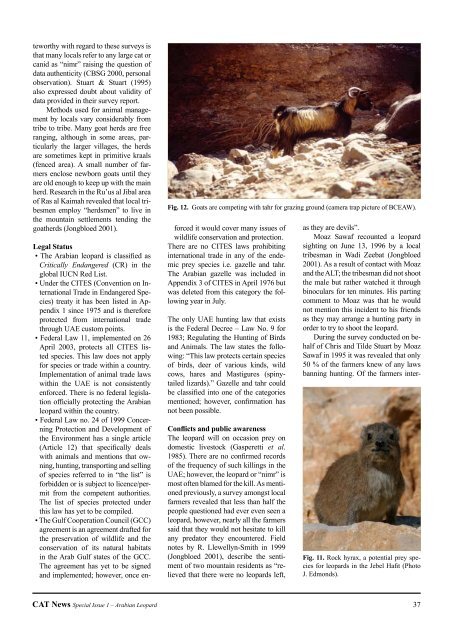Status and Conservation of the Leopard on the Arabian Peninsula ...
Status and Conservation of the Leopard on the Arabian Peninsula ...
Status and Conservation of the Leopard on the Arabian Peninsula ...
You also want an ePaper? Increase the reach of your titles
YUMPU automatically turns print PDFs into web optimized ePapers that Google loves.
teworthy with regard to <str<strong>on</strong>g>the</str<strong>on</strong>g>se surveys is<br />
that many locals refer to any large cat or<br />
canid as “nimr” raising <str<strong>on</strong>g>the</str<strong>on</strong>g> questi<strong>on</strong> <str<strong>on</strong>g>of</str<strong>on</strong>g><br />
data au<str<strong>on</strong>g>the</str<strong>on</strong>g>nticity (CBSG 2000, pers<strong>on</strong>al<br />
observati<strong>on</strong>). Stuart & Stuart (1995)<br />
also expressed doubt about validity <str<strong>on</strong>g>of</str<strong>on</strong>g><br />
data provided in <str<strong>on</strong>g>the</str<strong>on</strong>g>ir survey report.<br />
Methods used for animal management<br />
by locals vary c<strong>on</strong>siderably from<br />
tribe to tribe. Many goat herds are free<br />
ranging, although in some areas, particularly<br />
<str<strong>on</strong>g>the</str<strong>on</strong>g> larger villages, <str<strong>on</strong>g>the</str<strong>on</strong>g> herds<br />
are sometimes kept in primitive kraals<br />
(fenced area). A small number <str<strong>on</strong>g>of</str<strong>on</strong>g> farmers<br />
enclose newborn goats until <str<strong>on</strong>g>the</str<strong>on</strong>g>y<br />
are old enough to keep up with <str<strong>on</strong>g>the</str<strong>on</strong>g> main<br />
herd. Research in <str<strong>on</strong>g>the</str<strong>on</strong>g> Ru’us al Jibal area<br />
<str<strong>on</strong>g>of</str<strong>on</strong>g> Ras al Kaimah revealed that local tribesmen<br />
employ “herdsmen” to live in<br />
<str<strong>on</strong>g>the</str<strong>on</strong>g> mountain settlements tending <str<strong>on</strong>g>the</str<strong>on</strong>g><br />
goa<str<strong>on</strong>g>the</str<strong>on</strong>g>rds (J<strong>on</strong>gbloed 2001).<br />
Legal <str<strong>on</strong>g>Status</str<strong>on</strong>g><br />
• The <strong>Arabian</strong> leopard is classified as<br />
Critically Endangered (CR) in <str<strong>on</strong>g>the</str<strong>on</strong>g><br />
global IUCN Red List.<br />
• Under <str<strong>on</strong>g>the</str<strong>on</strong>g> CITES (C<strong>on</strong>venti<strong>on</strong> <strong>on</strong> Internati<strong>on</strong>al<br />
Trade in Endangered Species)<br />
treaty it has been listed in Appendix<br />
1 since 1975 <str<strong>on</strong>g>and</str<strong>on</strong>g> is <str<strong>on</strong>g>the</str<strong>on</strong>g>refore<br />
protected from internati<strong>on</strong>al trade<br />
through UAE custom points.<br />
• Federal Law 11, implemented <strong>on</strong> 26<br />
April 2003, protects all CITES listed<br />
species. This law does not apply<br />
for species or trade within a country.<br />
Implementati<strong>on</strong> <str<strong>on</strong>g>of</str<strong>on</strong>g> animal trade laws<br />
within <str<strong>on</strong>g>the</str<strong>on</strong>g> UAE is not c<strong>on</strong>sistently<br />
enforced. There is no federal legislati<strong>on</strong><br />
<str<strong>on</strong>g>of</str<strong>on</strong>g>ficially protecting <str<strong>on</strong>g>the</str<strong>on</strong>g> <strong>Arabian</strong><br />
leopard within <str<strong>on</strong>g>the</str<strong>on</strong>g> country.<br />
• Federal Law no. 24 <str<strong>on</strong>g>of</str<strong>on</strong>g> 1999 C<strong>on</strong>cerning<br />
Protecti<strong>on</strong> <str<strong>on</strong>g>and</str<strong>on</strong>g> Development <str<strong>on</strong>g>of</str<strong>on</strong>g><br />
<str<strong>on</strong>g>the</str<strong>on</strong>g> Envir<strong>on</strong>ment has a single article<br />
(Article 12) that specifically deals<br />
with animals <str<strong>on</strong>g>and</str<strong>on</strong>g> menti<strong>on</strong>s that owning,<br />
hunting, transporting <str<strong>on</strong>g>and</str<strong>on</strong>g> selling<br />
<str<strong>on</strong>g>of</str<strong>on</strong>g> species referred to in “<str<strong>on</strong>g>the</str<strong>on</strong>g> list” is<br />
forbidden or is subject to licence/permit<br />
from <str<strong>on</strong>g>the</str<strong>on</strong>g> competent authorities.<br />
The list <str<strong>on</strong>g>of</str<strong>on</strong>g> species protected under<br />
this law has yet to be compiled.<br />
• The Gulf Cooperati<strong>on</strong> Council (GCC)<br />
agreement is an agreement drafted for<br />
<str<strong>on</strong>g>the</str<strong>on</strong>g> preservati<strong>on</strong> <str<strong>on</strong>g>of</str<strong>on</strong>g> wildlife <str<strong>on</strong>g>and</str<strong>on</strong>g> <str<strong>on</strong>g>the</str<strong>on</strong>g><br />
c<strong>on</strong>servati<strong>on</strong> <str<strong>on</strong>g>of</str<strong>on</strong>g> its natural habitats<br />
in <str<strong>on</strong>g>the</str<strong>on</strong>g> Arab Gulf states <str<strong>on</strong>g>of</str<strong>on</strong>g> <str<strong>on</strong>g>the</str<strong>on</strong>g> GCC.<br />
The agreement has yet to be signed<br />
<str<strong>on</strong>g>and</str<strong>on</strong>g> implemented; however, <strong>on</strong>ce en-<br />
Fig. 12. Goats are competing with tahr for grazing ground (camera trap picture <str<strong>on</strong>g>of</str<strong>on</strong>g> BCEAW).<br />
forced it would cover many issues <str<strong>on</strong>g>of</str<strong>on</strong>g><br />
wildlife c<strong>on</strong>servati<strong>on</strong> <str<strong>on</strong>g>and</str<strong>on</strong>g> protecti<strong>on</strong>.<br />
There are no CITES laws prohibiting<br />
internati<strong>on</strong>al trade in any <str<strong>on</strong>g>of</str<strong>on</strong>g> <str<strong>on</strong>g>the</str<strong>on</strong>g> endemic<br />
prey species i.e. gazelle <str<strong>on</strong>g>and</str<strong>on</strong>g> tahr.<br />
The <strong>Arabian</strong> gazelle was included in<br />
Appendix 3 <str<strong>on</strong>g>of</str<strong>on</strong>g> CITES in April 1976 but<br />
was deleted from this category <str<strong>on</strong>g>the</str<strong>on</strong>g> following<br />
year in July.<br />
The <strong>on</strong>ly UAE hunting law that exists<br />
is <str<strong>on</strong>g>the</str<strong>on</strong>g> Federal Decree – Law No. 9 for<br />
1983; Regulating <str<strong>on</strong>g>the</str<strong>on</strong>g> Hunting <str<strong>on</strong>g>of</str<strong>on</strong>g> Birds<br />
<str<strong>on</strong>g>and</str<strong>on</strong>g> Animals. The law states <str<strong>on</strong>g>the</str<strong>on</strong>g> following:<br />
“This law protects certain species<br />
<str<strong>on</strong>g>of</str<strong>on</strong>g> birds, deer <str<strong>on</strong>g>of</str<strong>on</strong>g> various kinds, wild<br />
cows, hares <str<strong>on</strong>g>and</str<strong>on</strong>g> Mastigures (spinytailed<br />
lizards).” Gazelle <str<strong>on</strong>g>and</str<strong>on</strong>g> tahr could<br />
be classified into <strong>on</strong>e <str<strong>on</strong>g>of</str<strong>on</strong>g> <str<strong>on</strong>g>the</str<strong>on</strong>g> categories<br />
menti<strong>on</strong>ed; however, c<strong>on</strong>firmati<strong>on</strong> has<br />
not been possible.<br />
C<strong>on</strong>flicts <str<strong>on</strong>g>and</str<strong>on</strong>g> public awareness<br />
The leopard will <strong>on</strong> occasi<strong>on</strong> prey <strong>on</strong><br />
domestic livestock (Gasperetti et al.<br />
1985). There are no c<strong>on</strong>firmed records<br />
<str<strong>on</strong>g>of</str<strong>on</strong>g> <str<strong>on</strong>g>the</str<strong>on</strong>g> frequency <str<strong>on</strong>g>of</str<strong>on</strong>g> such killings in <str<strong>on</strong>g>the</str<strong>on</strong>g><br />
UAE; however, <str<strong>on</strong>g>the</str<strong>on</strong>g> leopard or “nimr” is<br />
most <str<strong>on</strong>g>of</str<strong>on</strong>g>ten blamed for <str<strong>on</strong>g>the</str<strong>on</strong>g> kill. As menti<strong>on</strong>ed<br />
previously, a survey am<strong>on</strong>gst local<br />
farmers revealed that less than half <str<strong>on</strong>g>the</str<strong>on</strong>g><br />
people questi<strong>on</strong>ed had ever even seen a<br />
leopard, however, nearly all <str<strong>on</strong>g>the</str<strong>on</strong>g> farmers<br />
said that <str<strong>on</strong>g>the</str<strong>on</strong>g>y would not hesitate to kill<br />
any predator <str<strong>on</strong>g>the</str<strong>on</strong>g>y encountered. Field<br />
notes by R. Llewellyn-Smith in 1999<br />
(J<strong>on</strong>gbloed 2001), describe <str<strong>on</strong>g>the</str<strong>on</strong>g> sentiment<br />
<str<strong>on</strong>g>of</str<strong>on</strong>g> two mountain residents as “relieved<br />
that <str<strong>on</strong>g>the</str<strong>on</strong>g>re were no leopards left,<br />
as <str<strong>on</strong>g>the</str<strong>on</strong>g>y are devils”.<br />
Moaz Sawaf recounted a leopard<br />
sighting <strong>on</strong> June 13, 1996 by a local<br />
tribesman in Wadi Zeebat (J<strong>on</strong>gbloed<br />
2001). As a result <str<strong>on</strong>g>of</str<strong>on</strong>g> c<strong>on</strong>tact with Moaz<br />
<str<strong>on</strong>g>and</str<strong>on</strong>g> <str<strong>on</strong>g>the</str<strong>on</strong>g> ALT; <str<strong>on</strong>g>the</str<strong>on</strong>g> tribesman did not shoot<br />
<str<strong>on</strong>g>the</str<strong>on</strong>g> male but ra<str<strong>on</strong>g>the</str<strong>on</strong>g>r watched it through<br />
binoculars for ten minutes. His parting<br />
comment to Moaz was that he would<br />
not menti<strong>on</strong> this incident to his friends<br />
as <str<strong>on</strong>g>the</str<strong>on</strong>g>y may arrange a hunting party in<br />
order to try to shoot <str<strong>on</strong>g>the</str<strong>on</strong>g> leopard.<br />
During <str<strong>on</strong>g>the</str<strong>on</strong>g> survey c<strong>on</strong>ducted <strong>on</strong> behalf<br />
<str<strong>on</strong>g>of</str<strong>on</strong>g> Chris <str<strong>on</strong>g>and</str<strong>on</strong>g> Tilde Stuart by Moaz<br />
Sawaf in 1995 it was revealed that <strong>on</strong>ly<br />
50 % <str<strong>on</strong>g>of</str<strong>on</strong>g> <str<strong>on</strong>g>the</str<strong>on</strong>g> farmers knew <str<strong>on</strong>g>of</str<strong>on</strong>g> any laws<br />
banning hunting. Of <str<strong>on</strong>g>the</str<strong>on</strong>g> farmers inter-<br />
Fig. 11. Rock hyrax, a potential prey species<br />
for leopards in <str<strong>on</strong>g>the</str<strong>on</strong>g> Jebel Hafit (Photo<br />
J. Edm<strong>on</strong>ds).<br />
CAT News Special Issue 1 – <strong>Arabian</strong> <str<strong>on</strong>g>Leopard</str<strong>on</strong>g> 37


